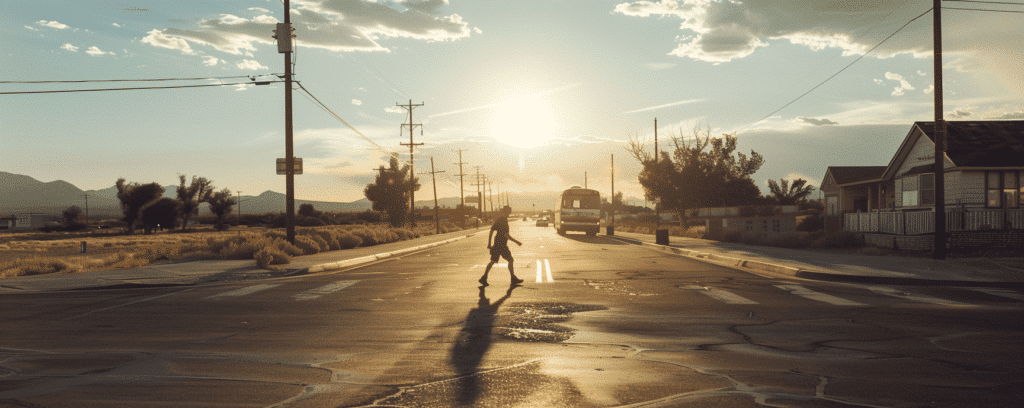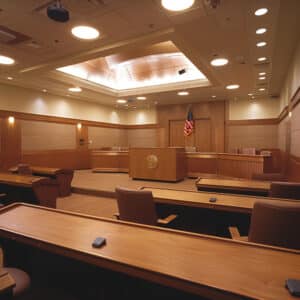
What is a pedestrian accident? It’s a serious incident where a vehicle hits an individual walking, often leading to severe consequences. This article elucidates the causes, effects, and preventative measures for pedestrian accidents, providing essential insights for understanding and addressing these distressing events.
Key Takeaways
- Pedestrian accidents involve various vehicle types and occur in numerous settings, with children, the elderly, and lower socioeconomic individuals being most at risk. Recognizing the specific dynamics of pedestrian accidents can inform prevention strategies and legal actions.
- Common causes of pedestrian accidents include distracted driving, speeding, failing to signal, not yielding at crosswalks, substance impairment, and pedestrian negligence such as jaywalking. Awareness and modification of risky behaviors by both drivers and pedestrians are critical for prevention.
- Pedestrian accidents can result in severe injuries, substantial economic costs, and complex legal and insurance claims. Immediate medical attention, accurate injury documentation, and consultation with pedestrian accident lawyers are crucial for recovery and pursuing rightful compensation.

Definition of Pedestrian Accidents
A pedestrian accident occurs when a person on foot collides with a moving vehicle, leading to potentially devastating consequences. This broad category of accidents is not limited to interactions with cars but extends to a variety of vehicles such as trucks, motorcycles, bicycles, buses, and trams, including the possibility of a car accident. The unpredictability of pedestrian accidents is further underscored by their occurrence in diverse settings ranging from urban areas and rural roads to parking lots and residential driveways, where an accident happened. For more information and insights, you can refer to pedestrian accidents blog posts.
Certain demographics are particularly prone to being involved in pedestrian accidents. Some of these include:
- Children, due to their small stature and unpredictable behavior
- The elderly, with their slower response times and mobility challenges
- Individuals of lower socioeconomic status, who may lack access to safe transportation options
These groups are at a higher risk of being involved in pedestrian accidents.
Gaining knowledge about the specifics of pedestrian mishaps paves the way for effective prevention. It also aids in dealing with the legal aftermath of such incidents, an aspect where the expertise of pedestrian accident lawyers can be invaluable.
Types of Vehicles Involved in Pedestrian Accidents
No single type of vehicle is immune to causing pedestrian accidents. The risk extends to all types of moving vehicles, including:
- cars
- trucks
- motorcycles
- bicycles
- buses
- trams
The type of vehicle involved can significantly affect both the impact on the pedestrian and the resultant legal and medical considerations.
For instance, collisions with larger vehicles like trucks and buses often result in severe injuries due to their size and weight. Accidents involving motorcycles and bicycles can also result in significant harm, despite their smaller size, due to the speed at which they move and the lack of protective barriers. Hence, grasping the impact of various vehicles in these mishaps is key to implementing preventive measures and taking appropriate legal steps.
Common Locations
Pedestrian accidents often occur in urban settings, particularly in areas not designated for crossing. Non-intersection areas in cities, where poor lighting at night and alcohol consumption contribute to increased risks, are frequent accident spots. Roadways where pedestrians stand, play, or work are also common accident sites, underscoring the need for vigilance in all areas where pedestrians are present.
Common Causes of Pedestrian Accidents
While the circumstances of each pedestrian accident are unique, certain factors commonly contribute to these incidents, including traffic accidents. These include driver-related factors such as:
- distracted driving
- speeding
- failing to signal
- not yielding the right of way at crosswalks
Substance impairment due to alcohol, drugs, or medication is another significant factor in many pedestrian accidents, affecting both drivers and pedestrians.
In addition to these, pedestrian actions play a significant role in many accidents. Inadequate yielding of the right of way and improper crossing at roadways or intersections are frequent contributors to pedestrian accidents. Recognizing these frequent causes is essential as it offers valuable perspectives for prevention and seeking legal recourse.
Distracted Driving
In the era of constant connectivity, distracted driving has emerged as a leading cause of pedestrian accidents. Activities such as:
- texting
- making phone calls
- using smartphones
- using infotainment systems
- using other electronic devices
Engaging in distracting activities while driving significantly increases the risk of car accidents. These activities divert the driver’s attention from the road, making them less aware of pedestrians and other potential hazards.
Texting while driving is particularly dangerous as it involves visual, manual, and cognitive distractions. This combination significantly increases the likelihood of collisions with pedestrians. Hence, removing distractions while driving is a vital step towards accident prevention.
Speeding and Reckless Driving
Speeding and reckless driving behaviors pose a significant threat to pedestrians. These actions reduce a driver’s reaction time, preventing them from stopping or avoiding a pedestrian in time. The severity of injuries from pedestrian accidents generally increases with the vehicle’s speed at the time of impact.
Vehicle design can also affect the severity of a pedestrian’s injuries in an accident. For example, vehicles with larger front-end designs are likely to cause more severe injuries to pedestrians. Consequently, observing speed limits and embracing safe driving habits are fundamental to ensuring pedestrian safety.
Pedestrian Negligence
While drivers bear a significant responsibility for preventing accidents, pedestrians must also exercise caution. Pedestrian negligence, such as jaywalking and crossing streets in unsafe manners, significantly contributes to pedestrian accidents. Substance impairment due to drugs or alcohol also leads to an elevated accident risk by impairing pedestrian abilities and judgment.
By obeying traffic rules, using designated crossing areas, and being vigilant of their surroundings, pedestrians can markedly lower their accident risk. This is particularly important in high-traffic areas and during nighttime when visibility is reduced. Paying attention to traffic signals can further enhance pedestrian safety.
Consequences of Pedestrian Accidents
Pedestrian accidents carry severe consequences, both for the individual involved and society at large. In 2021 alone, pedestrian fatalities due to traffic crashes increased by 13% from the previous year, amounting to 7,388 deaths. Aside from the tragic loss of life, these accidents impose a significant economic burden, with global costs attributed to motor vehicle collisions and pedestrian injuries totaling $500 billion.
The aftermath of pedestrian accidents is not always immediately visible. Often, pedestrians may not immediately feel the pain from an accident due to the release of adrenaline and endorphins, which can mask pain. Non-economic damages, such as pain and suffering, also affect victims of pedestrian accidents. Comprehending these outcomes aids in devising efficient prevention strategies and guaranteeing sufficient recompense for victims.
Injuries and Medical Treatment
Pedestrian accidents often result in a range of injuries, from traumatic brain injuries to musculoskeletal damage, including fractures and ligamentous injuries particularly affecting the knee. The age of the pedestrian can also influence the type of injuries sustained. For instance, children are most frequently affected by head and neck injuries, whereas adults are more prone to musculoskeletal injuries.
Injuries from pedestrian accidents can lead to serious injuries and long-term disabilities, especially those that damage the legs and knees. Hence, prompt and suitable medical care is vital, even for seemingly minor injuries such as scrapes and bruises. Such attention ensures proper care and supports injury-related insurance claims.
The aftermath of a pedestrian accident is a crucial period for the injured individual, as the decisions made during this time can significantly affect their path to recovery. Here are some vital steps to take:
- Seek immediate medical attention to address any injuries.
- Ensure accurate documentation of injuries, including medical records and photographs.
- Consult with a pedestrian accident lawyer to understand your rights and options for legal recourse.
Taking these steps can help ensure that you receive the necessary medical care and legal support during this challenging time.
Legal Ramifications

- the driver
- property owners
- government bodies
- the pedestrians themselves when there is evidence of negligence
The extent of a pedestrian’s fault in an accident can decrease the total compensation they may receive from a settlement.
Despite their possible contribution to the accident, pedestrians typically retain the right to make an injury claim. However, their actions can impact the claim’s outcome. It is advisable for both drivers and pedestrians to consult with a pedestrian accident lawyer following an accident to understand their rights and potential legal recourse.
Insurance Claims and Coverage
Insurance plays a vital role in the aftermath of a pedestrian accident. Injured pedestrians may seek coverage from health and disability insurance policies, worker’s compensation, or auto insurance policies of the responsible party. An insurance company will investigate the details of the accident, injuries, and property damage before deciding on a claim.
Navigating this process can be complex and overwhelming, particularly for someone recovering from an accident. Engaging a pedestrian accident lawyer can be beneficial in managing negotiations with insurance companies, ensuring that any settlement offer adequately covers all expenses. The involvement of a lawyer can also prevent clients from making statements that could potentially jeopardize their claims.
Contact us today and we will help you get the compensation that you deserve.
Preventing Pedestrian Accidents
While it’s important to grasp the causes and outcomes of pedestrian accidents, adopting preventive measures is the most effective strategy. Both drivers and pedestrians have a crucial role in preventing such incidents. Drivers should stay alert and ready to halt for pedestrians, who should utilize sidewalks and crosswalks where possible and sidestep distractions in traffic environments.
Technological advancements such as the implementation of safety features in vehicles, including automatic emergency braking systems, can significantly reduce the chances of hitting a pedestrian. Similarly, education programs highlighting pedestrian right-of-way laws can decrease incidents of pedestrian accidents.
Driver Safety Practices
Safe driving practices are instrumental in avoiding pedestrian accidents. Here are some tips to ensure pedestrian safety:
- Adhere to speed limits, especially in pedestrian-dense areas like school zones and residential neighborhoods.
- Be prepared to slow down and stop when turning or entering a crosswalk.
- Always yield to pedestrians in crosswalks.
By following these practices, you can help prevent accidents and keep pedestrians safe.
Increased caution is necessary when reversing, and headlights should be used to improve visibility during poor lighting conditions. Eliminating distractions such as eating, grooming, or adjusting the car radio is vital to remain attentive to pedestrians and other road users. Ultimately, the responsibility lies with drivers to remain vigilant at all times and to avoid behaviors such as distracted, fatigued, or intoxicated driving.
Pedestrian Safety Tips
Pedestrians also have measures at their disposal to boost their safety. Crossing streets at designated crosswalks or intersections, where drivers expect to see pedestrians, is safer. Wearing bright clothing and reflectors, especially at night, can enhance visibility and ensure that drivers can see pedestrians more easily.
Staying alert and avoiding distractions such as texting or wearing headphones can help pedestrians be more aware of their surroundings and the presence of approaching vehicles. Where sidewalks or paths are available, pedestrians should prioritize their use rather than walking on the road.
Legal Assistance in Pedestrian Accidents
Legal aid frequently proves to be invaluable in the aftermath of a pedestrian accident. From navigating insurance claims to negotiating settlements and pursuing personal injury claims, a pedestrian accident lawyer can guide victims through the complex legal landscape. Expertise in legal areas such as workers’ compensation and personal injury law is essential for representing pedestrian accident victims in negotiations and potentially in court.
Lawyers can assist in the aftermath of a pedestrian accident by:
- Managing communications with insurance companies
- Filing claims
- Submitting required documentation
- Negotiating settlements on behalf of pedestrians and drivers involved in accidents
The role of legal professionals at the accident scene in the aftermath of a pedestrian accident cannot be overstated, as they can help in obtaining the necessary police report.
Navigating Insurance Claims
Handling insurance claims following a pedestrian accident can be an intimidating endeavor. Insurance companies may employ various tactics, including offering quick, low settlements or denying responsibility. Lawyers can assist in managing these negotiations, ensuring that any settlement offer adequately covers medical bills, lost income, pain and suffering, and any permanent impairments. In cases where a wrongful death claim arises, they can also help navigate the complexities of wrongful death lawsuits.
Having a lawyer involved in dealing with insurance adjusters can also help prevent clients from making statements that could potentially jeopardize their claims. The guidance and representation provided by a lawyer can be invaluable in securing a fair settlement.
Pursuing Personal Injury Claims
The process of filing a personal injury claim can be intricate. A pedestrian accident lawyer is crucial in proving negligence by showing that a legal duty of care was breached, causing injuries and damages. Attorneys can also help clients understand potential compensation for economic losses, such as healthcare costs and lost wages, as well as non-economic damages like pain and suffering.
The assistance of a pedestrian accident lawyer in this process can provide several benefits, including:
- Easing the burden on the victim
- Increasing the chances of a successful claim
- Providing expertise and guidance throughout the legal process
- Ensuring that victims receive the compensation they deserve
By working with a pedestrian accident lawyer, victims can navigate the complexities of their case and maximize their chances of a favorable outcome.
Frequently Asked Questions
What is a pedestrian accident?
A pedestrian accident occurs when a person on foot collides with a moving vehicle, and can involve different types of vehicles and settings.
What are the common causes of pedestrian accidents?
The common causes of pedestrian accidents are distracted driving, speeding, reckless driving, and pedestrian negligence, as well as substance impairment from alcohol, drugs, or medication. Be vigilant and cautious while on the road.
What are the consequences of pedestrian accidents?
Pedestrian accidents can result in fatalities, physical injuries, economic burdens, and non-economic damages such as pain and suffering. These consequences highlight the serious impact of pedestrian accidents on individuals and society.
How can pedestrian accidents be prevented?
To prevent pedestrian accidents, both drivers and pedestrians should follow safety practices such as adhering to speed limits, yielding to pedestrians, and avoiding distractions. These measures can significantly reduce the risk of accidents and improve safety for everyone on the road.
How can a lawyer help in the aftermath of a pedestrian accident?
A lawyer can assist in navigating legal procedures, negotiating with insurance companies, filing injury claims, and increasing the likelihood of receiving appropriate compensation after a pedestrian accident.
Last updated Thursday, June 20th, 2024 | Written by Puneet Garg






